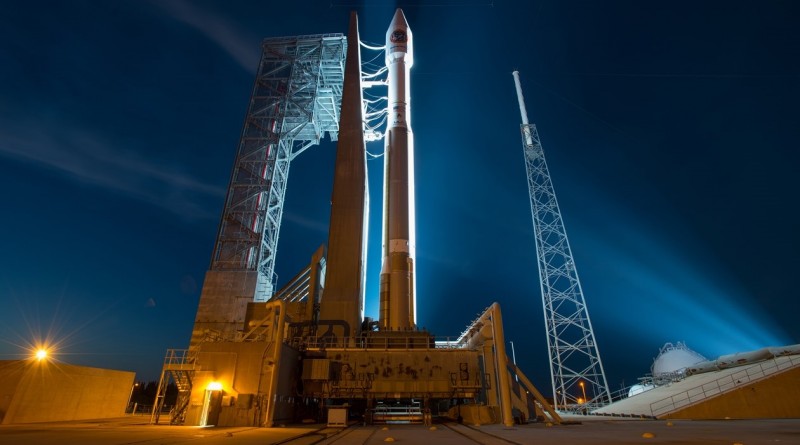ULA’s Atlas V to send Cygnus Cargo Ship to Orbit for ISS Resupply Mission & Spacecraft Fire Study
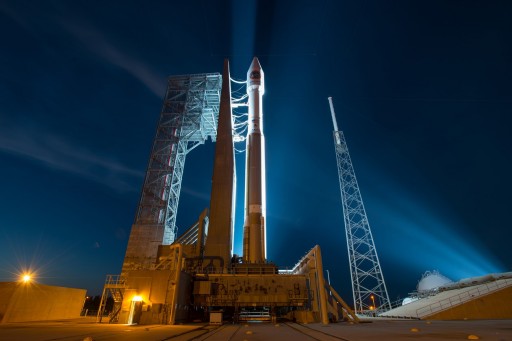
United Launch Alliance and Orbital ATK are ready to repeat their partnership in resupplying the International Space Station Tuesday night when an Atlas V rocket is scheduled to lift off from Florida’s Space Coast to send the Cygnus OA-6 cargo ship into orbit for a three-day flight to ISS ahead of a two-month stay.
ULA launched the Cygnus OA-4 vehicle, named S.S. Deke Slayton, in December as the first of two interim Cygnus flights using the Atlas V rocket while Orbital ATK’s Antares rocket is being re-fitted with new engines for its return to flight mission currently planned for NET June. The OA-4 vehicle spent over two months attached to the Space Station, delivering a record-setting 3,500 Kilograms of cargo for the six-person crew in orbit.
>>Live Launch Coverage & Updates
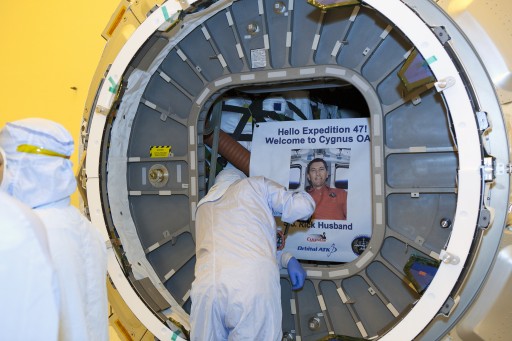
Atlas V is set for liftoff at 3:05 UTC on Wednesday, 11:05 p.m. local time on Tuesday, at the opening of a 30-minute window with five possible launch opportunities, taking advantage of the unique steering capability of Atlas V allowing what usually is an instantaneous window to be stretched to half an hour.
Firing its RD-180-powered Common Core Booster for just over four minutes, followed by a 13.5-minute burn of the trusted Centaur Upper Stage, Atlas V will deliver the 7,500-Kilogram spacecraft to an orbit 230 Kilometers in altitude from where it will catch up with ISS for a robotic capture on Saturday.
The Cygnus OA-6 spacecraft, named S.S. Rick Husband in honor of the fallen Space Shuttle Columbia commander, is loaded with 3,395 Kilograms of food, hardware and science headed to the Space Station to support the six crew members and over a dozen of scientific studies in progress aboard the orbiting laboratory.
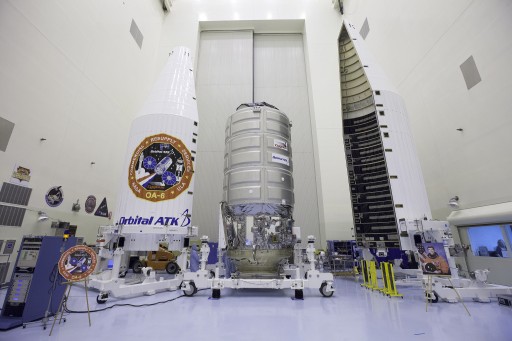
The Cygnus OA-6 mission comes right on the heels of the previous Cygnus flight, the first of the Enhanced Spacecraft Configuration featuring a stretched cargo module, new circular Ultra Flex solar arrays and improvements made on the Service Module of the spacecraft. The OA-4 flight was a complete success from start to finish without issues encountered by the modified Cygnus aside from a minor glitch related to higher-than-expected degradation on a cabin fan.
While the S.S. Deke Slayton was still in orbit, the Pressurized Cargo Module for OA-6 was delivered to the Kennedy Space Center to be loaded with cargo bags. Also in January, the Service Module made its trip from Virginia to KSC for final processing, being mated with the cargo module in early February followed by fueling activities. Initially, the mission was tracking a liftoff in early March, but had to be pushed when black mold spores were discovered on a cargo bag, requiring additional time for decontamination efforts.
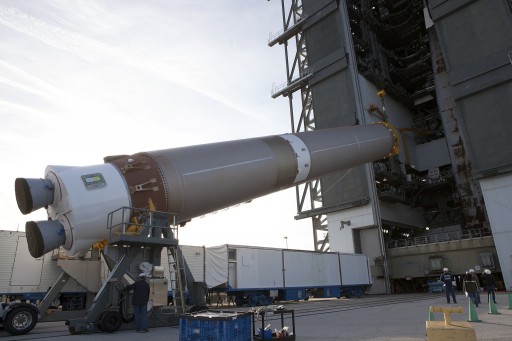
Cygnus’ ride to space took shape in mid-February when the Common Core Booster was delivered by the ULA Delta Mariner and moved to the Atlas Spaceflight Operations Center before its trip to the Vehicle Integration Facility at SLC-41 where it took its place atop the Mobile Launch Platform. The Centaur Upper Stage, already outfitted with its interstage adapter, was rolled to the launch facility a short time later to be hoisted and installed on the first stage.
On the 14th of March, the Cygnus spacecraft – encapsulated in the 4-meter Atlas V fairing – rolled to the launch complex and was attached to the Centaur Upper Stage. With Cygnus in position, the assembled rocket underwent detailed testing operations leading up to Friday’s Launch Readiness Review that cleared the mission for liftoff.
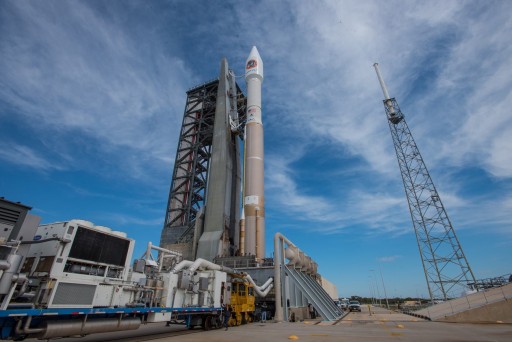
The 58-meter tall Atlas V was wheeled to the launch pad on Monday to enter its final day of preparations for a seven-hour countdown set to begin in the afternoon hours on Tuesday. Meteorologists are very positive about Tuesday’s launch attempt, having issued a 90% chance of favorable weather conditions during the half-hour window, only with a slight concern associated with cumulus clouds.
Beginning its flight with a nighttime blastoff atop the Atlas V rocket, Cygnus is set for a 21-minute ride into orbit after which the spacecraft will detach itself from the launch vehicle and enter a carefully engineered sequence of events starting out with the stabilization of its orientation and the deployment of its two solar arrays. Over a period of three days, the spacecraft will execute a series of maneuvers to raise its orbit and link-up with ISS to begin a careful approach on Saturday, climbing up to ISS from a position straight below. Astronaut Tim Kopra will be at the controls of the Space Station’s robotic arm to capture the S.S. Rick Husband at 10:40 UTC.
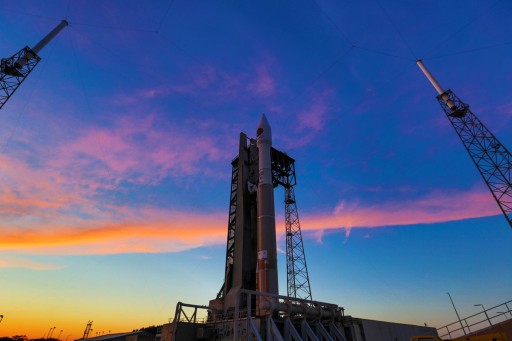
Cygnus is booked for a stay of nearly two months, remaining attached to the Unity module of ISS through mid-May. If everything goes according to plan, ISS will see its first period of dual-docked operations involving two commercial cargo craft on the U.S. Segment when the Dragon SpX-8 spacecraft arrives after its planned April 8 launch on a Falcon 9 to take up its spot at the Harmony berthing port. Dragon would be the first to leave the station again, headed for a parachute-assisted landing in the Pacific.
For Cygnus, the end of its mission looks very different. The spacecraft is set for a long free flight after departing ISS to facilitate the SAFFIRE combustion experiment – the first of three SAFFIRE runs planned for OA-5, 6 & 7 to study large-scale fires in microgravity by lighting a large piece of fabric on fire and gathering high-resolution video as well as data on oxygen consumption and temperatures. This is the first large-scale fire experiment in space and hoped to deliver valuable data to learn about flame growth in microgravity to better engineer fire safety systems in future spacecraft.
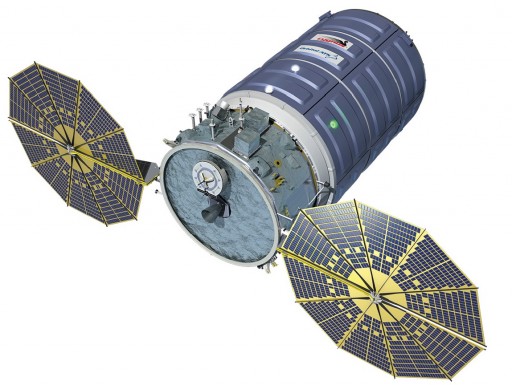
During the short experiment run that will only take six minutes for the combustion process itself, around 10GB of data will be gathered which will be downlinked over the course of one week. While spending additional time in orbit, Cygnus will introduce another new capability of releasing CubeSats from a NanoRacks deployment system installed on its Service Module.
To finish its mission, Cygnus will fire its engines to set up for a destructive re-entry over the Pacific Ocean, but data-gathering will not stop there since the OA-6 mission is the next flight of the REBR Re-Entry Break-Up Recorder to collect data during the fiery demise of the spacecraft to improve the knowledge of re-entry dynamics.
Countdown & Launch Sequence
Tuesday night’s launch has a 30-minute window which is unprecedented for a mission targeting a rendezvous in Low Earth Orbit. Typically, missions to the International Space Station only have an instantaneous window when the orbital plane of the Station moves into the precise position over the launch site. Instantaneous windows are used by SpaceX’s Falcon 9 and Japan’s H-IIB when launching ISS missions. The Russian Soyuz has a 10-second window which essentially can be considered instantaneous as well.
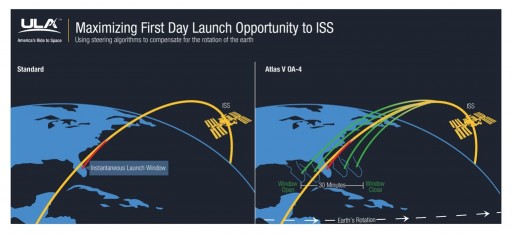
For vehicles capable of yaw-steering and quick-retargeting of ascent trajectories accounting for the rotation of the Earth, windows of a few minutes are possible – like the 10-minute launch window the Space Shuttle used to have.
To achieve a 30-minute window, United Launch Alliance uses two of its capabilities – the ability of Atlas V to steer back into an inertial plane by using some of its excess performance and ULA’s capability of quickly re-targeting the ascent trajectory of Atlas V by uploading a new trajectory file to the launcher’s flight computer to guide it into the orbital plane of ISS, flying out the cross range distance introduced by the rotation of the Earth.
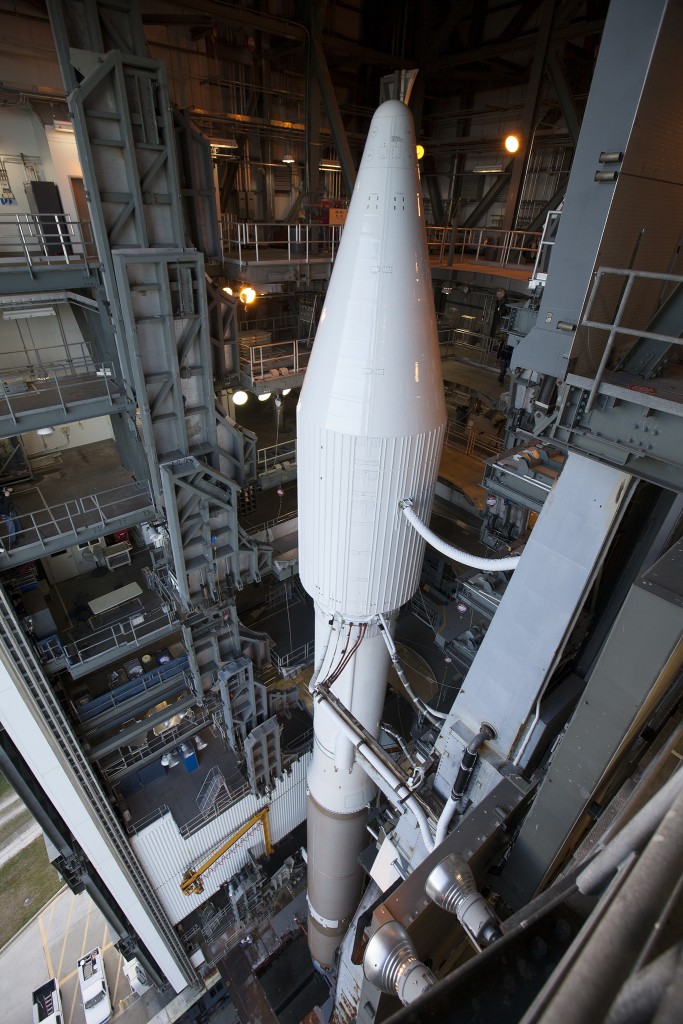
On launch day, five trajectory solutions will be available for Atlas V, spread across the launch window – the first at the opening of the window followed by four opportunities at 7.5-minute intervals, giving the vehicle plenty of opportunities to get off the pad in case of a last-minute hold-up due to weather or a technical snag.
Ahead of the countdown, technicians will already be busy at the pad, completing final hands-on work and closing out the Atlas V Integration Facility, pad facilities and the Atlas V launcher. The first step completed at T-6 Hours 20 Minutes is the activation of the Atlas V rocket.
The Atlas V 401 is the most basic and most-flown version of the Atlas V rocket. It uses the Common Core Booster as first stage with the trusted Centaur serving as upper stage. The vehicle stands 58.3 meters tall, is 3.81 meters in diameter and weighs 334,500 Kilograms at liftoff. No solid rocket motors are employed on this version of Atlas V. Atlas V 401 is topped by the short version of the 4-meter fairing.
Following the activation of the launcher, teams begin a series of checkouts of the electrical system of the rocket. Meanwhile, at the launch pad, technicians complete final hands-on work.
While that is in progress, the Launch Team puts the Atlas V through a series of communication checks on its S- and C-Band Systems.
Flight Termination System testing is also completed and the Nitrogen Purge flow on the vehicle is initiated. L-4 Hour commanding is performed by teams and by L-3 hours, the launch pad is cleared by all personnel.
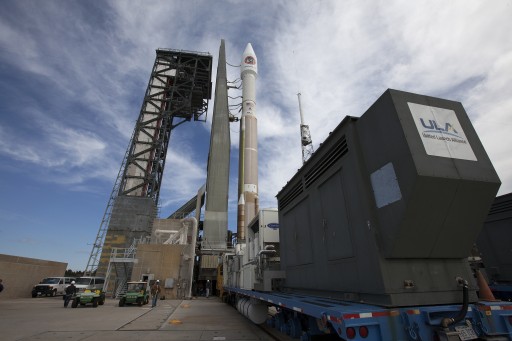
At T-2 Hours, the countdown enters a 30-minute built-in hold during which teams perform the fueling pre-task briefing and the GO/No GO Poll for propellant loading. As soon as the countdown resumes at T-2 Hours, propellant loading operations start. The complex procedure to load the two stages of the rocket with cryogenics begins with the chilldown of ground support equipment, transfer lines and tanks chilldown on the Liquid Oxygen side. Liquid Oxygen starts flowing into the Centaur upper stage tanks shortly thereafter. Centaur LOX loading takes about 40 minutes as 15,700 liters of –183-degree Celsius oxidizer are filled into the upper stage.
Once Centaur is into propellant loading, the large Liquid Oxygen tank of the Common Core Booster also starts fueling. LOX load on the CCB also moves through the three steps, slow-fill, fast-fill and topping. The Common Core Booster is loaded with Rocket Propellant 1 (refined Kerosene) ahead of the launch countdown. The large Common Core Booster that stands 32.46 meters tall with a diameter of 3.81m and a fuel load of 185,500 liters of LOX and 94,600 liters of RP-1.
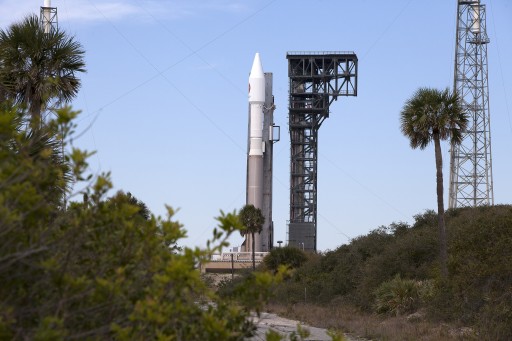
The final tank to be loaded during the countdown is the Liquid Hydrogen Tank of the upper stage that also goes through the usual steps. Centaur is loaded with a total of 48,100 liters of -253-degree Celsius LH2 fuel. The Centaur stage is 12.68 meters tall and 3.05 meters in diameter with over 200 previous missions under its belt.
When clocks reach T-4 Minutes, the countdown enters its final built-in hold. This hold can be extended in case of technical issues or uncooperative weather, taking advantage of Atlas V’s long launch window that includes five T-0 opportunities to send Cygnus on its way to ISS. During the hold, the launch team receives a final weather briefing and performs the GO/No GO Poll for the Terminal Countdown.
As clocks start ticking down from T-4 Minutes, final vehicle configurations such as ordnance arming, flight termination system arming, propellant tank pressurization, transfer to internal power, and flight control system reconfigurations will be made as part of the Automated Sequence to place the vehicle in its launch configuration.
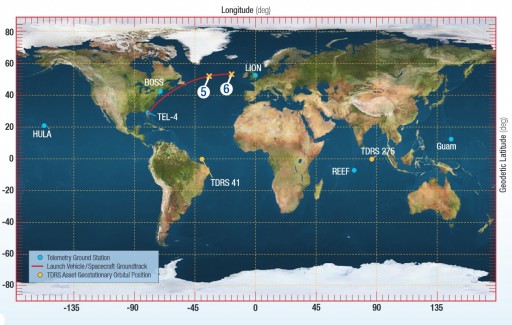
At T-2.7 seconds, the massive two-chamber RD-180 main engine of the Common Core Booster ignites and soars up to its full liftoff thrust of 390,250 Kilogram-force. Engine start-up is closely monitored by flight computers to make sure it reaches operational conditions before the launcher is committed to flight. As clocks hit zero, the hold-down system releases the launcher and Atlas V blasts off.
Without any Solid Rocket Boosters, the Atlas V 401 makes a relatively slow initial ascent with a Thrust to Weight Ratio of 1.16.
After ascending vertically for 18 seconds, the Atlas V will begin its pitch and roll maneuver to align itself with its pre-determined flight path, departing Florida’s Space Coast to the north-east on a coast-hugging trajectory. Lifting off in the dark of night, Atlas V will be widely visible along the East Coast of the United States.
After 73 seconds, the rocket passes Mach 1 followed by Maximum Dynamic Pressure about 11 seconds later. As the first stage approaches the 4-minute mark into the flight, it will start throttling down its RD-180 engine to maintain a maximum acceleration of 5 Gs. During first stage flight, the Centaur Upper Stage initiates Reaction Control System pressurization and boost-phase chilldown.
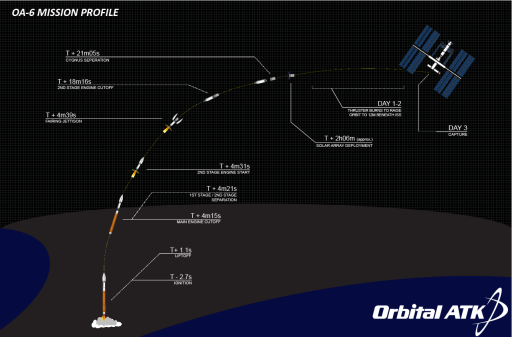
Four minutes and 16 seconds into the flight, the first stage will shut down its RD-180 engine. At T+4:22, six seconds after shutdown, pyrotechnics will be fired to separate the Common Core Booster that then uses eight small solid rocket motors to move away from the Centaur upper stage.
At T+4:32, the RL-10C engine of the Centaur Upper Stage will ignite on its first and only burn of this mission. This burn is planned to be 13 minutes and 38 seconds in duration using the 11,200kgf engine of the upper stage to push the stack into orbit. Seven seconds into the burn, Centaur will jettison its protective payload fairing.
Cygnus is aiming for a circular orbit of 230 Kilometers at an inclination of 51.6 degrees for spacecraft separation 20 minutes and 58 seconds after launch to begin its mission. The Centaur Upper Stage will complete a collision avoidance maneuver before conducting a deorbit maneuver.

